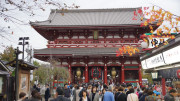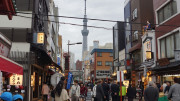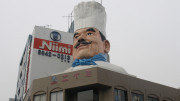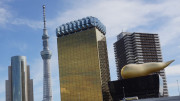Asakusa is located on the north-east fringe of Central Tokyo. It is located at the eastern end of the Ginza subway line and is situated in what is called the low city on the banks of the Sumida-gawa River. It is an extremely old area of Tokyo with quite a bit of history attached to it, and is well worthy of a visit.
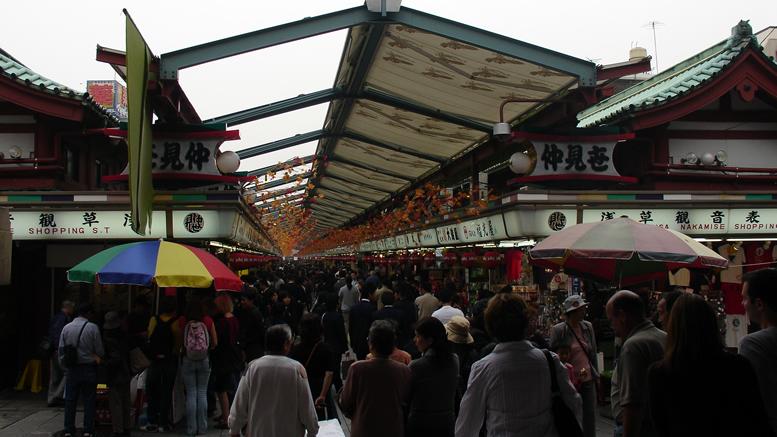
In the early twentieth century, the area was a substantial entertainment district and was Tokyo’s pleasure district with bars, clubs and a seedy underworld. The area was extensively rebuilt after the bombing raids of World War II. This is when the bars and clubs moved to Shinjuku, which is still today Tokyo’s entertainment capital.
There are still some small time entertainment establishments including small theatres and several pachinko parlours. The theatres specialise in showing classic old Japanese films that often draw large numbers of elderly Japanese tourists. One quaint attraction is the small amusement park known as Hanayashiki, near the Sensoji Temple. The amusement park is the oldest one in Japan and is tailored a bit more to younger children, with its charming old style carnival rides and fairground atmosphere.
Asakusa is also known as Tokyo’s oldest geisha district. There are around 45 of these ladies still working in and around the area’s many ryokan guest houses. With a lot of smaller scale lodgings in the area offering excellent value, the area is also regarded by many as a cheaper place to stay compared to the more commercialised parts of the city.
The Sensoji Temple is the most visited attraction in the area and one of Tokyo’s major tourist attractions. The temple attracts hundreds of worshippers every day, and even more tourists who flock to the market stalls and lovely photo opportunities in the bus loads. Sadly, many tourists who visit the temple don’t get to see the multitude of other things to see in the area. Asakusa has more than enough to do for a full day tour, but you can get to experience many of the sights in a half day.
The waterfront precinct is one of the modern areas of Asakusa, and the Asahi Beer Headquarters building is a must see. Although it has been given the tag of the “Golden Turd”, this fascinating piece of architecture is meant to resemble beer. Apart from some restaurants and bars around the building, the headquarters isn’t open to the public, but it is a fantastic photo opportunity especially if taken from one of the many watercraft that operates on the Sumida-gawa River.
For budding Iron Chef’s or people wanting anything for their kitchen Kappabashi-dori is a must, and is one of the most intriguing streets in Asakusa. Just about the entire street is devoted to selling kitchen ware. Whether it is household plates and cutlery or commercial equipment, the street has an incredible selection of things to purchase. Kappabashi is the place to buy the beautifully detailed plastic food replicas that you see in many of Japan’s restaurants. The choice is incredible, you can buy just about every type of plastic food, but be warned they can be expensive. But for an extremely affordable gift item, the Japanese crockery like plates, cups and saucers are so cheap, and many are positively beautiful; you can often pick up something for as little as 100 yen. Kappabashi-dori is easily spotted as the start of the street has an enormous chef head sculpture above one of the streets buildings.
A new addition to the Asakusa area’s skyline is the massive Tokyo Sky Tree, which is currently under construction and due for opening in 2012. This 634 metre tower will be used primarily for digital communication, but will feature viewing decks and monstrous retail and office space at its base. Developed by Tobu Railway, the tower is expected to cost 40 billion yen to complete. The tower once completed will be the world’s tallest tower. The Tower will rise 99 metres above the Tokyo Tower and when open is expected to be the second tallest structure in the world after the Burj Khalifa in Dubai. The Tokyo Sky Tree safely reached 625 metres on the day of the catastrophic Sendai Earthquake on March the 12th 2011.
To get to Asakusa take the Ginza subway line to the Asakusa Station, this is the last stop on the Ginza line. Tawaramachi Station is also in Asakusa on the Ginza line, a walk between these two stations would be an excellent way to see the sights of Asakusa. If you are heading to the area from the JR Yamanote line, you will need to swap to the Asakusa Metro line at Shimbashi, or the Ginza Metro Line at Shimbashi, Kanda or Ueno.

